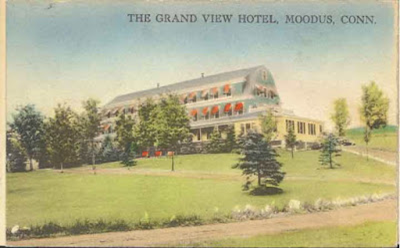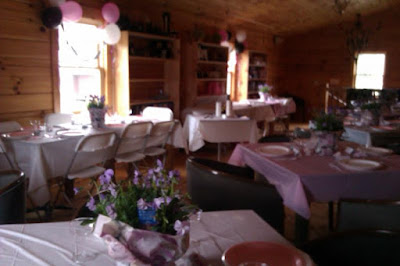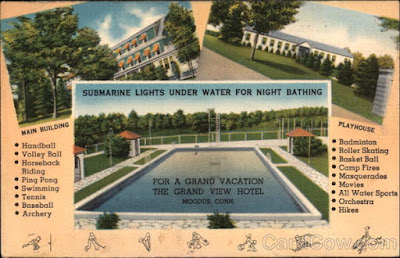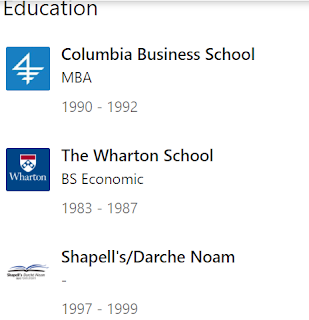Originally, the Grand View Hotel, the 22 acre property and numerous buildings were acquired by the Institute which operated from about 1982 to about 2002. It served as a recruitment vehicle for Machon Shlomo, a school for baalei teshuvah men in Israel. It is one of numerous buildings on the property as we will show.
The approach is straightforward: Create a cozy family-oriented
community focused intently but calmly on the opportunity for teshuvah…. The
potentially life-altering decisions played out in comfort–with a pool,
basketball, and barbecues. There were canoeing excursions to the Connecticut
River. The cuisine was superb. Service at mealtimes and in the rooms matched
what one would expect at a hotel. In fact, the original conception was to
create something striving for first class.” (Shemen Zayis Zach, p. 26)
When they tell you that the school is in Jerusalem, you picture Chassidim walking down narrow alleyways with children. You picture shuls and bakeries and butcher shops. You picture rich Jewish life, a kind of Paris for Judaism. You picture this:
Nobody tells you that the founders of MS intentionally chose an isolated location in a development site. You accessed it via a dirt road and in the beginning, entered the building -- one of the first in all of Har Nof -- via a wood plank. Bus service was infrequent. Here's MS's own description of what it was like:
Machon Shlomo was founded in 1982 with a small student body and a small staff, in an apartment building that stood at the entrance to a fledgling Jerusalem neighborhood called Har Nof. At the time, the community consisted of a dozen newly finished buildings perched atop a mountainside, flanked on either side by forest and miles of undeveloped land. The only road to the main city was a dirt path.
Personnel
Moodus had various people walking around, giving shiurim, guys from different yeshivas like Torah v'daas, Lakewood and the Mir, guys who are getting two free weeks in the country, one even who became a Rosh Yeshiva at RIETS of Yeshiva University. Today, he has 2,684 shiurim and articles on YUTorah.org. He was at Moodus but had nothing to do with Machon Shlomo. There was a rabbi from Detroit and one from Passaic. They were not Machon Shlomo staff. Nearly all of the rabbis that I encountered at Moodus were not the same ones that worked at Machon Shlomo.
In particular, the guy who ran both places was aloof at Moodus. You only interacted with him if you were invited to his dinner table, but he didn't talk much. Yet, at Machon Shlomo he dominated the place with his very dour view of life. Here's what he was like.
He taught his talmidim that most questions beginning with ‘Why?’ (unless they are in the form ‘Why does Rashi or Tosafos say this?’) are more likely than not to be products of the yetzer designed to deflect from a full Torah commitment. In question and answer sessions, he refused to answer as many questions as he was asked. First the questioner had to acknowledge what was really bothering him and how the information sought was relevant to his life.
That's from a memorial article written about him. Somehow the author deemed all that to be praise. But here's the translation: you are not allowed to ask questions as they come from the evil part of you. He didn't hit you with this at Moodus. As I said, he was aloof there. He let the hired hands (some paid with free vacations in the country) handle you.
The other main guy at Machon Shlomo, the one who ran the daily hour and a half long Chumash shiur, was in Israel during my time in Moodus. Only one of the three Gemara rebbes was at Moodus. All but two of the rabbis I met at Moodus were not Machon Shlomo rabbis.
Machon Shlomo had no visitors and no guest speakers that ever came to the yeshiva. (Two came briefly to siyumim on the first two books of Chumash. This was held in an apartment down the road.) Neighbors rarely even stopped by to join the minyan. We were isolated. Even within the school we were isolated as most of the small staff, most of who worked part-time as Gemara rebbes, were instructed not to speak to the bachurim about anything but the Gemara shiur. All hashkafa, halacha, and aitzah could only come from the founder, who was an unlearned baal habayis, and his 29 year-old son in law who was a baal teshuvah 6 years out of a Christian college when the place was founded. On top of that, neither of them was around very much. I remember being alone with the students most of the time. If you visit Machon Shlomo today, it's the same.
Atmosphere
The atmosphere at Moodus was generally laid back, except for a sales pitch about Machon Shlomo. As I explained, we spent most of the day playing sports.
The atmosphere at Machon Shlomo was super intense. There were three levels of Gemara shiurim for the first year students, and the feeling of elitism from the higher to the lower was palpable. The same held for the second year students toward the first. As one former student wrote, "In fact, guys are hand picked for their competitiveness and non-questioning nature. The rabbis know that the guys will hit the ground running and compete with each other to learn." This is all very different from Moodus.
Sales Pitch
At Moodus, we heard repeatedly about Machon Shlomo which they described as the Ivy-League yeshiva in Israel. Again and again, we were told how lucky we'd be to go there. But one had to be admitted. You had to have the right stuff. There was this feeling the whole time at Moodus of wanting to be approved of. That was one part of the atmosphere that was not laid-back. It turned out that the approval process actually wasn't too involved as a five minute conversation was all anyone had with me. But I had gone to an Ivy League school and that's all that mattered. They were looking for such guys on which to build their reputation. I have a friend who was told by one of the two men who ran the place that he "wasn't good enough" to go there.
The Ivy League Talk vs. Machon Shlomo
Machon Shlomo had and has nothing in common with the Ivy League. I talk about this extensively in another post. But here's a bit of it.
Ivy League schools have a huge variety of academic programs, 1000s of course offerings, beautiful campuses, visiting faculty, world-class faculty, massive libraries with millions of books, scores of foreign language offerings, diverse student bodies.
Princeton offers 42 doctoral departments and programs. Cornell has 16 schools and colleges. The University of Michigan (an Ivy equivalent) has 275 degree programs. Columbia has three undergraduate schools, thirteen graduate and professional schools, a world-renowned medical center, four affiliated colleges and seminaries, and more than one hundred research centers and institutes.
Machon Shlomo offered essentially two classes - Gemara b'iyun and Chumash with Rashi. The Gemara class came without any background on the Gemara and its strange style. We didn't even get a vocabulary sheet. No Ivy League school would just toss you into Gemara like that.Ivy League schools have huge libraries. Harvard's library has 16 million volumes, Yale has 12 million, Columbia 11 million, Cornell 8 million, Princeton 7 million, and Penn 6 million. That's six of the 18 largest university libraries with the Ivy's being in 1st, 3rd, and 5th place.
Machon Shlomo had no library, only a half-shelf of books. Even today the beis midrash has no bookshelves. As shown earlier, the walls are bare.
Faculty
Ivy League schools also have sizable and distinguished academic staff. Yale has an academic staff of 4,869 including 67 members of the National Academy of Sciences, 55 members of the National Academy of Medicine, 8 members of the National Academy of Engineering, and 187 members of the American Academy of Arts and Sciences.
Machon Shlomo had a staff of four rabbis, all of them effectively part time, one of them for second year students only, three of them gave the gemara shiurim, so students not in that Gemara shiur had nothing to do with that rabbi. So really you interacted only with a single rabbi and also the baal habayis and the new baal teshuvah who ran the place. At night a student and his chavruso would meet with a tutor for an hour to prepare for the next day's Gemara shiur. Even today, Machon Shlomo has a tiny staff, a fraction of what I saw at Moodus. Here's the staff page listing on the Machon Shlomo website as of July 2022. It's been this way for months.
Foreign Language Study
Ivy League schools have extensive foreign language course offerings and requirements for foreign studies departments. For example, the Princeton program in Near Eastern studies requires two years of Arabic, Hebrew, Hindi, Persian, Swahili, Turkish, or Urdu. The Stanford Eastern Studies department requires students to demonstrate Chinese, Japanese, or Korean language fluency at the third-year level or above, to be met either by coursework, examination, or a degree from a university where the language of instruction is in Chinese, Japanese, or Korean. Here are the Hebrew courses offered at UC Berkeley:
HEBREW 1A Elementary Hebrew 5 Units
HEBREW 1B Elementary Hebrew 5 Units
HEBREW 10 Intensive Elementary Hebrew 10 Units
HEBREW 11A Reading and Composition for Hebrew Speaking Students 5 Units
HEBREW 11B Reading and Composition for Hebrew-Speaking Students 5 Units
HEBREW 20A Intermediate Hebrew 5 Units
HEBREW 20B Intermediate Hebrew 5 Units
HEBREW 30 Intermediate Hebrew 10 Units
HEBREW 100A Advanced Hebrew 3 Units
HEBREW 100B Advanced Hebrew 3 Units
HEBREW 102A Postbiblical Hebrew Texts 3 Units
HEBREW 102B Postbiblical Hebrew Texts 3 Units
HEBREW 103A Later Rabbinic and Medieval Hebrew Texts 3 Units
HEBREW 103B Later Rabbinic and Medieval Hebrew Texts 3 Units
HEBREW 104A Modern Hebrew Literature and Culture 3 Units
HEBREW 104B Modern Hebrew Literature and Culture 3 Units
HEBREW 105A The Structure of Modern Hebrew 3 Units
HEBREW 105B The Structure of Modern Hebrew 3 Units
HEBREW 106A Elementary Biblical Hebrew 3 Units
HEBREW 106B Elementary Biblical Hebrew 3 Units
HEBREW N106 Elementary Biblical Hebrew 6 Units
HEBREW 107A Biblical Hebrew Texts 3 Units
HEBREW 107B Biblical Hebrew Texts 3 Units
HEBREW 111 Intermediate Biblical Texts 3 Units
HEBREW 148A The Art and Culture of the Talmud: Advanced Textual Analysis 3 Units
HEBREW 148B The Art and Culture of the Talmud: Advanced Textual Analysis 3 Units
HEBREW 190B Special Topics in Hebrew 3 Units
HEBREW H195 Senior Honors 2 - 4 Units
HEBREW 198 Directed Group Study for Upper Division Students 1 - 4 Units
HEBREW 199 Supervised Independent Study and Research 1 - 4 Units
HEBREW 201A Advanced Biblical Hebrew Texts 3 Units
HEBREW 202A Advanced Late Antique Hebrew Texts 3 Units
HEBREW 202B Advanced Late Antique Hebrew Texts 3 Units
HEBREW 203A Advanced Medieval Hebrew Texts 3 Units
HEBREW 203B Advanced Medieval Hebrew Texts 3 Units
HEBREW 204A Advanced Modern Hebrew Literature and Culture 3 Units
HEBREW 204B Advanced Modern Hebrew Literature and Culture 3 Units
HEBREW 206 Ancient and Modern Hebrew Literary Texts 3 Units
HEBREW 298 Seminar 1 - 4 Units
HEBREW 301A Teaching Hebrew in College 3 Units
HEBREW 301B Teaching Hebrew in College 3 Units
Ivy League schools have exchange students and visiting professors and students. At every college I attended, I met students from other schools as they visited friends or took classes at the college.
MS had nothing to do with any other yeshiva and not only that but certain persons at MS regularly engaged in disparaging all the other schools such that students jokingly referred to those schools as "the enemies." The result of that was a discouragement of visiting other schools on one's own.
Personal Freedom
Ivy League schools are famously liberal and free. Students construct their own majors, design their own courses, and engage in any number of clubs and projects.
At Machon Shomo, there were no electives. Rooms, roommates, seats, and chavrusos were assigned. We were not allowed to lead davening or to date. Machon Shlomo did not engage in any projects, no chesed projects, no publication projects. Nothing. It was dominated by a singular perspective such that many students jokingly referred to it as McClone Shlomo.
Introductory Classes
Ivy League schools and all colleges have introductory classes. That's the old 101. For example, at Stanford University (an Ivy equivalent) in the political science department you'll find the following:
POLISCI 102 Introduction to American Politics and Policy: Democracy Under Siege?
POLISCI 136R Introduction to Global Justice
POLISCI 153Z Strategy: Introduction to Game Theory
POLISCI 213E Introduction to European Studies
https://politicalscience.stanford.edu/graduate-program/current-courses
The Brown University political science concentration requires (not just offers) two introductory classes.
2 Two introductory courses from the following:
POLS 0110 Introduction to Political Thought
POLS 0200 Introduction to Comparative Politics
POLS 0400 Introduction to International Politics
https://polisci.brown.edu/undergraduate/concentration-requirements
Duke University, an Ivy equivalent, offers an array of introductory courses:
POLSCI 101 Introduction to Political Science
POLSCI 108 Introduction to African Studies (DS3 or DS4)
POLSCI 145 Introduction to Political Economy
POLSCI 160D Introduction to Security, Peace and Conflict
POLSCI 175 Introduction to Political Philosophy
POLSCI 189FS Introduction to Machine Learning and Computational Models in the Social Sciences
And those are just the ones with the word "introduction" in the title. There are many other introductory courses in 100-199 range. For example:
POLSCI 171FS Political Polarization in the US: Causes and Consequences SS
POLSCI 172FS Racial Attitudes and Racial Politics in the United States
POLSCI 176FS Human Rights and World Politics EI, SS
POLSCI 180FS Hierarchy and Spontaneous Order: The Nature of Freedom in Political and Economic Organizations (C-N) EI, W, SS
POLSCI 185FS The Politics of Language SS
POLSCI 186 Women and Gender in the Middle East
And these are just the intros to political science. Every department in the university has introductory classes. So there will be an introduction to macro economics, intro to micro economics, intro to econometrics, intro to sociology, intro to social psychology, intro to geology. A typical college will have scores of introductory courses. Doesn't all that sound interesting?
And wouldn't it be helpful too? The Maharetz Chajes said, “The importance for a beginner in secular fields to have clear introduction is obvious, but it is even more important when studying Torah.” He cites the Yerushalmi (Shabbos 87a): “any Torah without a foundation is not Torah.” Says Maharetz Chajes, “That means Torah without an understanding of basic rules and concepts....” (Introduction to Toras Nev’im in Daas Torah)
So when you come to the so-called Ivy League yeshiva, when you come to a school for newcomers to Orthodox Judaism, you reasonably expect to attend introductory courses. Machon Shlomo didn't have any of those. There was no introduction to Judaism, to hashkafa, to Gemara, to Hebrew, or to halacha. There was no introduction to anything! As I said, there were essentially two classes: Gemara iyun and Chumash with Rashi. The method for the former, was to open up Baba Matzia to daf beis and start reading. "Snayim ochazim b'tallis." The method for the latter was the same: "Bereishis bara Elokim." Rashi says....
Most other BT schools do have introductory courses. Ohr Somayach has a course called "Introduction to Judaism."
Machon Shlomo had none of this. Do you want to say that introductory classes are goyish? (Maharetz Chajes didn't think so.) Calling yourself the Ivy League yeshiva is goyish.
So before moving to Boston to pursue further graduate studies, he and Yael spent a year at the David Shapell College of Jewish Studies/Yeshiva Darche Noam in Jerusalem. “That year in Israel really accelerated my knowledge,” Aldrich said. “We both studied text full time. We came back to Boston fully observant.
Aldrich received a Ph.D. in Government from Harvard and his wife received an M.B.A. and an M.A. in Jewish Community Studies, both from Brandeis University. ( https://cssh.northeastern.edu/jewishstudies/faculty-profile-daniel-aldrich/)
Harry Rothenberg, Born and Raised: Philadelphia, PennsylvaniaColumbia University, BA: 1988, Harvard Law School, JD Magna Cum Laude: 1993Yeshivat Ohr Somayach Jerusalem: 3 years (https://ohr.edu/articles/harry.html)
"The program provided me with an introduction to Judaism that challenged and stimulated with its willingness to address fundamental questions and to examine the limits of belief." Nicholas Retter, BA, Harvard University (https://ohr.edu/1595)
Rabbi Jeremy Kagan grew up in Hawaii and attended Yale University, where he received a B.A. in Philosophy. While traveling in Israel during college he began his Torah studies, going on to learn in Ohr Sameach, Meshech Chochma, and Heichal HaTorah B’Tzion. (https://midreshettehillah.com/great-school/meet-the-directors/)
That was one of the truly cultish things about machon shlomo- the daily reinforcement of the idea that they had the patented ‘correct’ view of judaism and no one, not artscroll, not the chassidim, no one really ‘got it’ but them.”
I will say that they have a 2 week summer program where the head rabbis come to the US and do a little road show, complete with BBQ's and science and torah lectures mixed in. The atmosphere is very laid back and the kiruv part gets ratcheted up by the end. You get tefillin and learn about tzitis, etc. You get Kelemen style lectures that are supposed to put aside your doubts. The rabbis are nice and smart and credible. You figure, it can't be all that bad.The yeshiva focuses on getting as many doctors, lawyers, scientists, mba's as possible to the yeshiva. The strategy is: get these guys whipped into shape in 2 years (they get you to agree to 1 year, then make you feel like a loser if you don't keep going) then married and off into the world.
See, they are making the claim even though, as I have tried to explain, it's not accurate, not even close.




























































.JPG)



1 comment:
Machon Shlomo in the 1980s was the worst of all the BT schools if you can call it a school. Imagine recruiting guys from elite schools (not that they all were despite MS’s false advertising, but some were) and then sticking them in an isolated anti-intellectual environment. MS had 1 ½ classes 1) a Gemara b’inyun that was dumped on your head without any introduction to the material, without even a vocabulary sheet. 2) Chumash with Rashi that consisted mostly of a recitation of the text. It was given by a baal teshuvah (son in law of the head guy) who was 8 years out of college – Trinity College, which shows you how assimilated was his background. I consider that half a class. There was no instruction in Hebrew, Mishnah, Gemara b’ikiyus, history, Chassidus, musar, mitzvos, or hashkafa, and only a drop of halacha (and most of that indoctrination on how baal habatim and BTs shouldn’t be so arrogant as to try to understand halacha). We were told repeatedly that we weren’t ready for anything but the two classes. They told us also how we weren’t ready to date or to lead davening. So an ignorant baal habayis and his young BT son-in-law are ready to open and run their own yeshiva, but the students aren’t ready to hear some introductory halacha. How can you possibly become frum if you aren’t taught anything about mitzvos. Questions were mocked. There were no guest speakers, no trips, no visits to gadolim. We didn’t go to simchas. There wasn’t a real facility; it was a few apartments in a building that was the first in a new development. In other words, we weren’t really in Jerusalem as advertised. We were in a development site, a rocky field mostly. There was no library. Any guy who was actually from an Ivy League school was used to massive libraries. MS had a half-shelf of books. The main theme of the place was that bachurim are arrogant and need to be humbled and that every other yeshiva or part of the Jewish world was wrong or bad and only Machon Shlomo had the truth. The place was not just a joke. It was a cult. I fully believe their goal was to destroy people.
Post a Comment